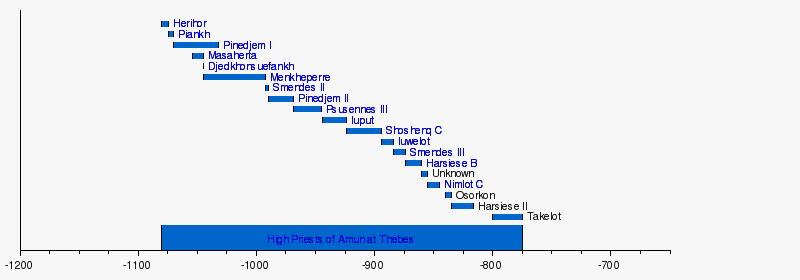Theban High Priests of Amun
- See High Priests of Amun for high priests from the New Kingdom (dynasties 18-20).
While not regarded as a dynasty, the High Priests of Amun at Thebes were nevertheless of such power and influence that they were effectively the rulers of Upper Egypt from 1080 to c. 943 BCE, after which their influence declined. By the time Herihor was proclaimed as the first ruling High Priest of Amun in 1080 BCE—in the 19th Year of Ramesses XI—the Amun priesthood exercised an effective stranglehold on Egypt's economy. The Amun priests owned two-thirds of all the temple lands in Egypt and 90 percent of her ships plus many other resources.[1] Consequently, the Amun priests were as powerful as the Pharaoh, if not more so. One of the sons of the High Priest Pinedjem I would eventually assume the throne and rule Egypt for almost half a decade as pharaoh Psusennes I, while the Theban High Priest Psusennes III would take the throne as king Psusennes II, the final ruler of the Twenty-first Dynasty of Egypt.
The High Priests
21st Dynasty
- Pinedjem I Son of Piankhi by Hereret. Father of Djedkhonsiufankh, Masaharta and Psusennes I. Wife: Isetemkheb II.
- Masaharta, Son of Pinudjem I and Isetemkheb II. High Priest from at least year 16 until Year 24 of King Nesibanebdjedet I (Smendes I).
- Djedkhonsuefankh, Second son of Pinudjem I, brother of Masaharta.
- Menkheperre, Son of Pinudjem I. Became High priest after his brother during year 25 of Nesibanebdjedet I.
- Smendes II (Egyptian name Nesibanebdjedet II) Son of Menkeperre II and Isetemkheb III. Served as high Steward under his father and ultimately became high priest of Amun himself. Served under Amenemipet, Osorkon and Siamen.
- Pinedjem II, Son of Menkheperre and Isetemkheb III. Followed his brother Nesibanebdjedet II as high priest of Amun.
- Psusennes III
22nd Dynasty
- Iuput, Son of Shoshenq I high priest of Amun for most of his father’s reign, and into the reign of his brother Osorkon I. 944-924 BC
- Shoshenq C (possibly identical to Sheshonk II), Son of Osorkon I and Maatkare B. Served as high priest of Amun at Karnak for large part of his father’s reign.
- Iuwlot, Son of Osorkon I. Probably became high priest of Amun late in the reign of Osorkon I and served until the early years of Takelot I.
- Nesibanebdjedet III (Smendes III), Son of Osorkon I. Served as high priest of Amun during the middle of the reign of his brother Takelot I.
- Harsiese B, Son of Soshenq II. Promoted to high priest of Amun under Osorkon II. 874-860 BC
- Nimlot C, Son of Osorkon II. Became high priest of Amun after year 16 . The name of his predecessor […du/aw…] was erased. 855-845 BC
- Takelot F (see Takelot II), Son of Nimlot III. Followed his father as high priest of Amun before probably becoming a Theban King as Takelot II. 845-840 BC
- Osorkon B (see Osorkon III), Eldest son of Takelot II. Probably became high priest of Amun after his father assumed kingship. 840-785 BC Later took the throne as Osorkon III.
- Osorkon F, probably son of Rudamun and grandson of Osorkon III?
- Harsiese, son of […du/aw…] i.e. Pedubast? 835-800 BC.
Third Intermediate Period timeline

References
- ↑ Clayton, Peter A. (2006). Chronicle of the Pharaohs: The Reign-by-Reign Record of the Rulers and Dynasties of Ancient Egypt. Thames & Hudson. ISBN 978-0-500-28628-9.
See also
- People of the Twenty-first Dynasty of Egypt
- Twenty-first dynasty of Egypt Family Tree
- Twenty-first Dynasty of Egypt topics
